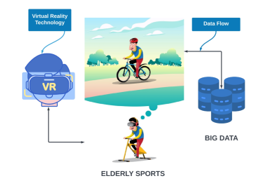Research on the Application of Virtual Reality Technology in the Elderly Sports Industry in the Era of Big Data
Keywords:
Artificial intelligence, Big data, Elderly sports, Virtual realityAbstract
The rapid development of artificial intelligence technology has resulted in the growth of every single technology under it such as machine learning and deep learning technologies. This research focus on the Immersive Technology names as Virtual Reality and Big data and how they both are correlated in the aspects of elderly sports. The trainer of any virtual reality technology in geriatric sports faces significant obstacles in monitoring and doing exercises, training, monitoring the player’s actions, and food monitoring. The coach uses the most up-to-date information technology to keep track of the player within that regard. The coach and also the players are taught how to use mobile applications to communicate with one another in an interactive way. Also, even if the athlete is located in a rural place, the coach might recommend some monitoring tools to be acquired and used for ongoing checking of a player’s activity. In this research, neural network model has been used to analyze the application of Virtual Reality Technology in the elderly sports Industry in the era of big data. The results provided an accuracy of 99.89% in evaluating the performance.
Downloads
References
J. -M. Lee and S. -K. Kim, “Analysis of the application status and prospects of augmented reality and virtual reality in sports convergence industry : Based on social big data analysis,” The Korea Journal of Sport, no. 3, pp. 139–151, Sep. 2021, doi: 10.46669/kss.2021.19.3.013.
Y. W. Liu, “The application of virtual reality technology on modern sports,” Adv. Mat. Res., pp. 593–595, Jan. 2013, doi: 10.4028/www.scientific.net/amr.650.593.
G. X. Li, “Research on application of computer technology in the virtual reality in sports,” Adv. Mat. Res., pp. 2024–2027, Oct. 2014, doi: 10.4028/www.scientific.net/amr.1049-1050.2024.
J. Wang, “Research on application of virtual reality technology in competitive sports,” Procedia Eng., pp. 3659–3662, 2012, doi: 10.1016/j.proeng.2012.01.548.
Y. M. Jiang, “Research on the application of virtual reality technology on industry automatic simulation,” Adv. Mat. Res., pp. 1155–1159, Feb. 2012, doi: 10.4028/www.scientific.net/amr.463-464.1155.
B. Wang and Z. Z. Wu, “Research on application of computer virtual reality technology in sports training,” Adv. Mat. Res., pp. 2694–2697, May 2014, doi: 10.4028/www.scientific.net/amr.926-930.2694.
H. An-Long, “Research into the application of virtual reality technology in simulation of sports training,” Inf. Technol. J., no. 20, pp. 5689–5692, Oct. 2013, doi: 10.3923/itj.2013.5689.5692.
C. J. Liu, “Research on application and development of competitive sports simulation based on virtual reality technology,” Adv. Mat. Res., pp. 1063–1068, Jan. 2011, doi: 10.4028/www.scientific.net/amr.179-180.1063.
E. Olshannikova, A. Ometov, Y. Koucheryavy, and T. Olsson, “Visualizing big data with augmented and virtual reality: challenges and research agenda,” J. Big Data, no. 1, Oct. 2015, doi: 10.1186/s40537-015-0031-2.
K. Lee, “Virtual reality gait training to promote balance and gait among older people: A randomized clinical trial,” Geriatrics (Basel), vol.6, no.1, 2020, doi: 10.3390/geriatrics6010001.
K. Khushnood, S. Altaf, N. Sultan, M. M. Ali Awan, R. Mehmood, and S. Qureshi, “Role Wii Fit exer-games in improving balance confidence and quality of life in elderly population,” J. Pak. Med. Assoc., vol. 71, pp. 2130–2134, 2021, doi: 10.47391/JPMA.319.
J. P. Higgins, J. Thomas, J. Chandler, M. Cumpston, T. Li, M. J. Page et al., Cochrane Handbook for Systematic Reviews of Interventions. Hoboken, NJ, USA: John Wiley & Sons, 2019.
S. Y. Babadi and H. Daneshmandi, “Effects of virtual reality versus conventional balance training on balance of the elderly.” Exp. Gerontol. Vol. 153, no. 111498, 2021, doi: 10.1016/j.exger.2021.111498.
Y. Chen, Y. Zhang, Z. Guo, D. Bao, and J. Zhou, “Comparison between the effects of exergame intervention and traditional physical training on improving balance and fall prevention in healthy older adults: a systematic review and meta-analysis.” J. NeuroEng. Rehabil. Vol. 18, pp. 164, 2021, doi: 10.1186/s12984-021-00917-0.
M. Lesinski, T. Hortobágyi, T. Muehlbauer, A. Gollhofer, and U. Granacher, “Effects of balance training on balance performance in healthy older adults: A systematic review and meta-analysis,” Sports Med. Vol. 45, pp. 721–1738, 2015, doi: 10.1007/s40279-015-0375-y.
M. F. Levin, P. L. Weiss, and E. A. Keshner, “Emergence of virtual reality as a tool for upper limb rehabilitation: Incorporation of motor control and motor learning principles,” Phys. Ther. Vol. 95, pp. 415–425, 2015, doi: 10.2522/ptj.20130579

Downloads
Published
How to Cite
Issue
Section
License
Copyright (c) 2022 Sheng Gao, Liang Tang

This work is licensed under a Creative Commons Attribution-ShareAlike 4.0 International License.
All papers should be submitted electronically. All submitted manuscripts must be original work that is not under submission at another journal or under consideration for publication in another form, such as a monograph or chapter of a book. Authors of submitted papers are obligated not to submit their paper for publication elsewhere until an editorial decision is rendered on their submission. Further, authors of accepted papers are prohibited from publishing the results in other publications that appear before the paper is published in the Journal unless they receive approval for doing so from the Editor-In-Chief.
IJISAE open access articles are licensed under a Creative Commons Attribution-ShareAlike 4.0 International License. This license lets the audience to give appropriate credit, provide a link to the license, and indicate if changes were made and if they remix, transform, or build upon the material, they must distribute contributions under the same license as the original.





